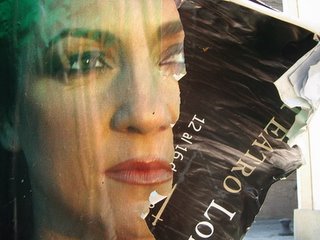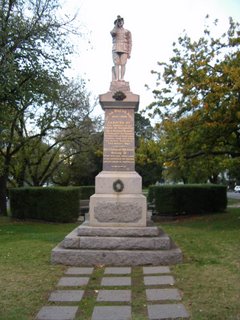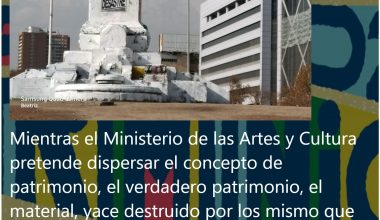 Public Space – Art and Urban Planning
Public Space – Art and Urban Planning
ARC Biennial
Art, Design and Craft Biennial, October 20 – 30 2005
Brisbane City Hall, Queensland, Australia
Anthony McInneny
This is an edited version of a paper presented by Anthony McInneny on behalf of Architects for Peace as one of a panel of three speakers that included Timothy Hill (architect and partner of Donovan Hill) and Jay Younger (associate professor at Queensland College of Art). The panel was to respond to the following question:
“If public art is an essential feature of a well-designed city, why are so many projects deemed failures? Panelist discuss the future of public art, and the responsibilities of planners and decision-makers to the public (and vice versa)”
I was invited to speak on this panel in response to an overview I wrote of a conference entitled IntentCity conducted by Architects for Peace. The conference was ambitious; free to the public, outdoor in a public space and funded by individual members, not a government department. One of the central ideas of the conference was to discuss the political city in a new space claimed for public debate rather than passive recreation.
When I think of Public Art, my mind immediately imagines objects in public spaces. The evolution of public art practice has been successful in extending the notion beyond sculpture in public spaces and has skilled up, as it were, visual and performing artists to work in the public realm and collaborate (or to chose not to collaborate) with other practices, agents and professions of the built environment. As Jay Younger pointed out, public art programs have provided a lot of employment for artists and is similar in many ways to a public works program for artists.
Creative processes of administration and commissioning (if that is not a contradiction in terms) have tended to shut down in the face of controversy. This is particularly the case in Melbourne spanning the Vault in the 1970’s to the recent fiasco with painted trees near the sacred MCG in 2004. Unfortunately, independent benefactors in Australia have not been keen to fund a public art program similar to the New York Public Art Fund or Artangel.
The assumption in the question for today’s panel is that we live and work within well-designed cities and that in some way public art has failed the city.
Artworks crystallize the times in which they are made and within which we live. Perhaps we not only get the politicians we deserve but also the public artworks.
“In other countries it has been well recognized that often artists are the spearhead for subsequent gentrification of areas where space is cheap”. In an argument for a national percentage for arts capital works program[1], the National Association for the Visual Arts (NAVA) proffers that “In other countries it has been well recognized that often artists are the spearhead for subsequent gentrification of areas where space is cheap”. This is probably true but I don’t remember the speculative property market as being part of the artist’s intent. Speculative property markets and speculative financial markets in general have dominated our economy, psychology, culture and public spaces. Gentrified cities and public spaces reflect a certain social agenda, one of exclusion through income and in the absence of meaningful social housing policy. How can public art in this setting reflect anything more that urban tourist attractions for the commuters or an expression of status or lost heritage for the residents?
The suburban sprawl of most of Australia’ capital cities could hardly be described as well designed. Car dependent, low density, dormitory suburbs with houses larger than can be lived in, heated or cooled and furnished with every form of entertainment as a consolation for a lack of social and built infrastructure. Without increased density in our suburbs, public transport and social infrastructure are not viable. We are trapped in an individual, car centric world that demonstrates the failures of urban planning and public policy. The city centre becomes an island and the outer suburbs, where the majority of people live, becomes less sustainable and separated from social and political life.
 The image of the bus stop/ad shell is included for a number of reasons.
The image of the bus stop/ad shell is included for a number of reasons.
It reminds me of the visual pollution created throughout our cities as we abdicate our right to not be subjected to propaganda in our most public of public spaces. It would appear that this form of rented public space is the only way this country can afford a second rate commuter transport system.
I have a sense of nostalgia for the idea that I once caught a piece of public artwork. The W class trams of Melbourne, painted by established and aspiring artists, were a quaint notion of public art in the late 70’ and 80’s. We now stand at billboards and consent to catching and becoming part of advertising campaigns.
A recent artwork I developed was not able to be located on the preferred site because, in part, it obscured the view of such an advertisement.
Lastly, it is not unusual for advertising and art to appropriate one another but this reproduction of Holbein’s Ambassadors has a peculiar twist. The anamorphic skull representing mortality has been removed for no apparent reason.
While the streets of CBD Melbourne are full of public artworks, very few actually deal with the notion of public space in any more successful or meaningful way than the monuments of conquest and war that dominated Australian cities for over half the 20 Century. Perhaps the comparison with these monuments is not too far off the mark. What types of memorials will be made for the War on Iraq and the never ending War on Terror? Perhaps we are making them in our cities and as artists in a state of amnesia or denial.
 In another step into this twilight zone, historic monuments for “just wars”, WWI and WWII, are being stripped of their relevance, their site specificity as it were, by being relocated from public places of daily life to memorial precincts or closer to the club for the diggers. The example illustrated is the First World War bugler to be relocated from the major intersection of Station Street and Whitehorse Road in Box Hill at the request of the local RSL.
In another step into this twilight zone, historic monuments for “just wars”, WWI and WWII, are being stripped of their relevance, their site specificity as it were, by being relocated from public places of daily life to memorial precincts or closer to the club for the diggers. The example illustrated is the First World War bugler to be relocated from the major intersection of Station Street and Whitehorse Road in Box Hill at the request of the local RSL.
In a similar fashion, art precincts are the resting place for tired or problematic public artworks. Most notably, the Vault has found its final resting place in the public space surrounding its architectural equivalent, the Australian Centre for Contemporary Art, ACCA. A recent exhibition at ACCA during the Melbourne Festival was an empty room with the light switched off by the exhibiting artist who works in the public domain, Martin Creed. This is epic stuff according to the experts. An easily dismissed one-line joke becomes disturbingly serious when art teachers, with VCE students in tow, explain how they become part of an artwork by entering a dark room.
The most recently created public space in Melbourne, Federation Square, is a cluster of commendable cultural and institutional buildings that surrounds an open air, undulating public artwork by Paul Carter. This work forms the surface of the square that dissuades sitting, standing or any other activity for that matter except for consumption on the perimeters in cafes. Like a 1950’s house on a quarter acre block that ignores the backyard, Federation Square turns its back on the Yarra River and, to complete the suburban metaphor places a large screen television as the dominant feature in the corner of this public living room. When guests arrive, and I would argue that we are all guests in Federation Square, you have to turn the telly down or off if you want to talk but please, don’t sit on the new furniture because there is nowhere to sit.
The most symbolic of our public institutions, the new Parliament House in Canberra was designed with a gesture to the public. Able to walk over Parliament House, we demonstrate participatory democracy. While down the hill, the Aboriginal embassy struggles to maintain it’s heritage status in front of the Old Parliament House turned into yet another museum of democracy, a fitting end to the idea that parliament actually represents people was a community/public art project commemorating the Centenary of Federation. 1000 cardboard cutouts of significant members of our communities, nominated and decorated by citizens were the last people to walk on the grass roof of parliament house. This was 2001 just before the barricades went up.
“In line with a review of security and access, the commissioning body is pursuing opportunities to incorporate landscape and artwork as elements which not only increase the amenity of the reserve, but will limit car access to sensitive government buildings[1]”
“In line with a review of security and access, the commissioning body is pursuing opportunities to incorporate landscape and artwork as elements which not only increase the amenity of the reserve, but will limit car access to sensitive government buildings[2]”
This is an excerpt of an “Artist’s Brief” I recently received and, perhaps foolishly, submitted my resume as an expression of interest. The only other surprise was the fact that the turn around time on this project from concept to installation was less than four months. This is a project for a major site in Melbourne CBD. This is not an isolated case in the flurry of developments and events for the Commonwealth Games in March 2006. All briefs have an agenda, even straight commissions but I have never seen one that explicitly states that art should be a security barrier.
The trouble with commissioning bodies that are public institutions or instrumentalities is not that they have a constituency to which they answer but that very few of the people who represent or have power within these bodies actually value art for what it is, not what it does. There is an almost total disregard for the artistic process to develop a response to a site over a period of time. Art is not simply a design process.
One would be naïve to think that a government or private developer would actually fund works of dissent. What is less apparent is that the room for dissent to actually exist is being squeezed out of public space.
I am a great supporter of the City of Melbourne. I believe that many of its programs are artist focused. I am a member of the Public Art Advisory Committee. The work illustrated is the work of Aslan McClennan. This is part of a body of work that was deemed unacceptable for the City Lights gallery. What was also unacceptable and banned from the 24/7 Gallery that is partly sponsored by the City of Melbourne was a body of works on the Israeli/Palestinian conflict. The first in this series was an Israeli flag covered with statistics about the number of Palestinians killed and significant political and historical dates and events. The second proposed work of a Palestinian Flag with similar information on Israeli casualties never got to see the light of day. The first work was ordered to be removed.
I found a subtle indication of our inability to objectively look at history in an exhibition of migrant gardens in Brisbane in City Hall today. Historical background is provided referring in one instance to the invasion of Afghanistan and in another to the Vietnam Civil War. The fact that we were directly involved in the later and not the former is not mentioned.
Moving to private public space, the Docklands in Melbourne in an attempt to incorporate artworks in public spaces has done two things badly. Individually the artworks are significant pieces. What the Docklands authority has done is to return to the notion of “plop art” and in doing so have either created an outdoor gallery for works that bare no relationship to the site or co-opted works into private spaces, the foyers and facades of buildings. This gallery and the waterfront become a forecourt for the apartments and, like Federation Square, unless you are consuming or attending an “event” there is little reason to visit. That the Docklands is actually public space in anything other than land title may change with the collapse of the investment property market.
 I will close my discussion with the image of one of a series of six “successful” works for freeways in Melbourne. This public art project was developed by a group of Western suburb Councils in Melbourne who are trying to convey that the traditionally working class, industrial suburbs are undergoing a transition – effectively one could argue it is part of a marketing exercise. I have chosen the work of landscape architects Sinatra Murphy who have created a full scale rendering of a McMansion in two-point perspective that floats above the clover leaf of a freeway intersection. I see this work as a public art version of the popular television series Kath and Kim. Popular because it demonstrates a reciprocal snobbery of suburban and urban living that does little to question the unsustainable nature of urban sprawl or consumption.
I will close my discussion with the image of one of a series of six “successful” works for freeways in Melbourne. This public art project was developed by a group of Western suburb Councils in Melbourne who are trying to convey that the traditionally working class, industrial suburbs are undergoing a transition – effectively one could argue it is part of a marketing exercise. I have chosen the work of landscape architects Sinatra Murphy who have created a full scale rendering of a McMansion in two-point perspective that floats above the clover leaf of a freeway intersection. I see this work as a public art version of the popular television series Kath and Kim. Popular because it demonstrates a reciprocal snobbery of suburban and urban living that does little to question the unsustainable nature of urban sprawl or consumption.
Figure 1: Bus shelter in Mitcham, Melbourne
Figure 2: Bugler, First World War monument Box Hill, Melbourne
Figure 3: Aslan McClennan. You Need Me. Stencil artwork for City Lights Gallery. Image courtesy of the Artist Figure 4: House in the Sky. Sinatra Murphy Landscape Architects. Western Ring Road, Melbourne.
[1] NAVA Quarterly, September 2005 No. PP242800/00004 ISBN 1032 9617
[2] Expression of Interest document from the department of Treasury and Finance





